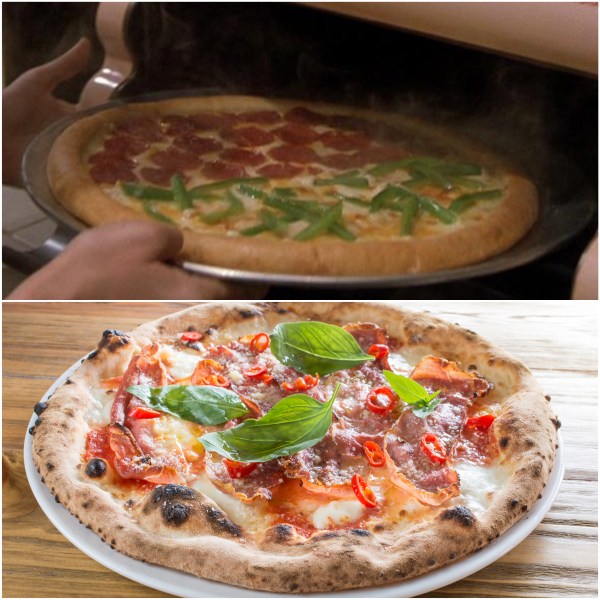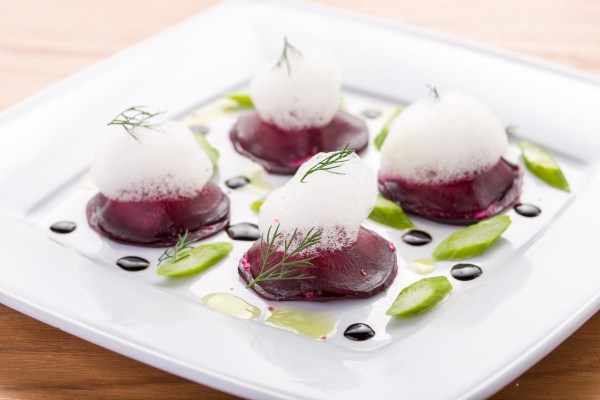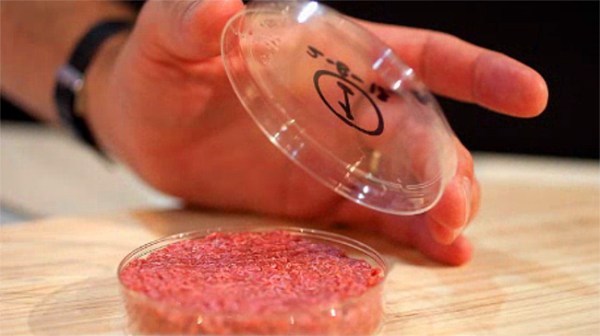
The new era of "balanced breakfast."
This article is part of #Future, a new UPROXX section that covers where the world is headed and how things have changed since 1989. Powered by Toyota.
When Back to the Future Part II hit theaters in 1989, it put forth a vision for how the world might look on October 21, 2015 — offering bold predictions for how we would travel (hoverboards! flying cars!), how we would dress (self-fitting clothes! self tying sneakers!), and how we would eat (rehydrated pizza!).
Some of the predictions never quite gelled (fax machines and laser disks barely made it out of the 90s) while others were spot on (our obsession with 3D and sequels). Here are Michael J. Fox and Christopher Lloyd discussing what the movie got right, where it missed, and how it might still be proven accurate in days to come:
When you’re talking food, the most memorable scene in Back to the Future Part II happens in the McFly kitchen — where the family enjoys a drop down garden and pizza prepared in seconds. With this scene as a leaping off point, we spoke to food luminaries about what has come to pass and where things are headed with regard to where we get our food, the way it’s prepared, and how it tastes.
The Age Of Uniformity Has Ended

Back to the Future Part II's notion of 2015 uniformity vs. a modern-day wood fired pizza.
In the Back to the Future Part II-era, the country was still focused on everything looking the same (a hangover from the age of industrialization and the era of pervasive food borne illness). Food was mass produced and over-packaged. The clean lines and simple construction of Lunchables made us feel like astronauts — it was an industrial revolution meal, the Tinker Toys of the culinary world.
These days, we’re seeing mass production rejected — all-artisan-everything is the focus. We spoke to Ali Bouzari of the food innovation lab Pilot R + D and he explained the situation thusly:
It took us about 30 years after World War II to really hit the peak of this attitude that said, ‘We want all food to look the same all the time, and you can trust that because that tells us that it’s safe.’ These days we’re far removed from that era, and the reaction is more like, ‘Yeah, it’s safe, and it all looks the same, but now there’s very little intrigue to it, and there’s very little wholesomeness to it.’ We’re realizing that the separation from nature may not be the best thing.
Bouzari, no stranger to speculation on where food is headed, sees the craft/small batch/artisan trend as one that will continue in the years to come.
“I think now, we’re going back to being aware of the fact that the hamburger you’re eating used to be an animal,” he explains. “Or that produce that we’re buying had to grow somewhere. We want to sense that in every food experience that we have.”
In the photos above, we see the ultra-uniform rehydrated pizza that the McFlys rally around and a wood-fired pizza pockmarked with char. As Bouzari notes, modern food aficionados are going to be far more excited about the irregular looking pie — a trend which looks to continue as we begin to worry less about uniformity and learn to celebrate “ugly food.”
Farmers And Chefs Will Team Up For Smart Sourcing
At the zenith of the mass produced food era, where and how something was grown didn’t really matter much to the end user. By 2011, when this famous Portlandia sketch aired, the pendulum had swung completely in the other direction — it was all about “local.”
Now, in 2015, the “grow local” movement has evolved even further. In Dan Barber’s The Third Plate: Field Notes on the Future of Food, he envisions a more comprehensive system of culinary sustainability:
It helps us recognize that what we eat is part of an integrated whole, a web of relationships, that cannot be reduced to single ingredients. It champions a whole class of integral, yet uncelebrated, crops and cuts of meat that is required to produce the most delicious food.
Evan Marks — founder of The Ecology Center in San Juan Capistrano, California — has long been on the cutting edge of permaculture and the conversation over sustainable food. His annual Green Feast and regular “Community Table” events have acted like idea labs for those who feel passionately about the future of how and what we eat. We spoke to Marks and one of his favorite chefs, Greg Daniels of Haven Gastropub in Orange (California).
The two men are a perfect illustration of the changing nature of food sourcing. While the relationship used to go top down — the chef talks to the supplier who talks to the warehouse who talks to the farmer — these days the relationship is becoming more and more direct (particularly at high-level eateries).
“It’s becoming less about the chef saying, ‘Here’s what I want to make,'” Marks explains, “and more about the farmer coming and saying, ‘This is what I have.’ It’s a two-way dialogue that says, ‘abundance creates deliciousness.'”
Chef Daniels agrees with this and sees chefs as a potential engine for change. He’s been involved in combating California’s historic drought and works closely with ecologists like Marks, local farmers, and ranchers to ensure the sustainability of the products he puts on the plate.
“Over the past few years, my chef de cuisine and I have been replacing ingredients that aren’t up to our standards from a sourcing standpoint,” Daniels explains. “It starts with big things and gets all the way down to sugar and flour — bringing in milled flours and organic sugars was a big step for us… one that we’re still tweaking.”
The challenge — which Daniels is quite cognizant of — is that good/smart/”slow” food costs a lot of money to produce. Evan Marks understands that chefs, who are trying to run a business, are hyper aware of this fact.
“The challenge between food with integrity and the typical consumer is the price point,” Marks says, “so part of the conversation is about saying ‘What is the middle? How do we find the middle ground?’ Once we locate that place where people are willing to pay, then the future goal can be to keep pushing forward to the edges through education.”
Savory Foods Will Get Remixed Via Molecular Gastronomy
When it comes to what will actually be on the plate (when it’s not pizza), Ali Bouzari of Pilot R + D thinks that the savory flavor profiles grouped together under the banner of “umami” will continue to be popular. He says:
Savory is very hot. Which is ironic because meaty, savory stuff feels very old-school America. We have this new knowledge of umami in the U.S., and that perfectly coincided with sugar being the new demon of the month. Right now, we hate sugar and we’ve discovered this love of savory things. The Holy Grail that we see chefs chasing as we head into the future are savory snack foods and savory protein bars, and ramen joints.
As Bouzari noted, often times those savory umami flavors that people are so excited about are centered around meat. But umami doesn’t exclusively come from meat, the flavors can be isolated in vegetables, too.
“Umami and savory flavors are the key to making vegetables taste good,” Bouzari continues. “It coincides really nicely with this more vegetarian mindset that a lot of people have now. Countries like Japan and India probably have the two best handles in the world on how to make vegetable-heavy food taste amazing. A lot of that is from the umami — which doesn’t just come from bloody steaks.”
Chef Greg Daniels agrees with Bouzari about veggies but adds that even as savory flavors flourish we’ll see protein sizes decrease.
We’re scaling back protein sizes and embracing the idea that people want to share things. I think meat can scale down to 3-4 ounces and still feel reasonable. We can create vegetarian dishes that uses meat as, essentially, garnish in order to deliver that flavor. And the more educated people get about meat production as a whole, the more I think we’ll see them being more selective about it.
Chef Jeffrey Boullt of Social, who trained at the world famous Commander’s Palace in New Orleans, sees these flavors getting remixed and filtered through new techniques.
“The goal,” he explains, “is to make the unfamiliar items feel approachable. I got people to try bone marrow by serving it with grilled cheese and bacon jam. I got people to eat a whole pig’s head by serving it as part of a carnitas taco platter.”
Boullt hopes to help diners open their minds to what’s new by giving them easy access points to connect with. This is his same approach he uses when it comes to introducing molecular gastronomy techniques — if accessibility can’t come through the way food looks, it has to come through familiar flavors. When he cooked for Uproxx, the chef used transglutaminase (a sort of meat-glue that bonds proteins) to make “rock shrimp crusted porchetta” and added the smoothing agent Ultra-Tex 8 to a puree to create liquefied andouille sausage. That may sound cutting edge, but it’s essentially pork and shellfish — a combo as old as the spatula. Still, even though his own foods tend toward the savory, Boullt knows that these food need balance.
“I can’t envision that the future will just be about knocking people out with heavy flavors,” he concludes. “I want to offer a flavor profile that’s balanced. As people get more and more savvy, they’re going to appreciate dishes that feel familiar, but don’t send them home in a food coma.”
The Food Supply Chain Will Move Into Urban Areas
In the Back to the Future Part II scene with the dehydrated pizza, the family supplements their meal with some fruit plucked from a terraced planter that drops down from the ceiling. Here, the movie was pretty close to spot on. We spoke to Erik Cutter, founder of Alegría Fresh — a company that develops vertical farming systems — about the plausibility of of a drop down garden.
“Do I see something dropping out of the ceiling?” he asks, “No. But I do see homes producing food (even if they don’t have traditional yards or garden space) by using living walls or vertical hydroponics.”
Cutter believes our current food supply system is unsustainable — both due to the carbon used in the supply chain and due to the lack of carbon in our soil. He goes on:
The future of food is going to be centered on one main concept: resiliency. We have to have a resilient supply of food that is accessible to people in cities. We have to stop transporting it so far and using so much carbon in the supply chain. My solution is to decentralize the big agricultural distribution system by providing supplemental micro-farms in the city. Zero waste, high performance urban micro farms with nutrient-rich soil. They’re off grid and they produce superior produce right where people live and work.
So in this case, the movie hit the mark. It might not look exactly the way it did in the movies, but the net effect — the journey from plant to table being a matter of inches not miles — may be exactly like we witnessed in Back to the Future Part II. This ability to get fresh produce onto people’s plates is a good thing, especially with every chef we spoke to predicting a world in which vegetables step more and more into a starring role. Cutter breezily mentions hosting farms on rolling hydroponic towers in unused parking lot space.
In addition to his theories on vertical farming, Cutter is also of the belief that good soil — rich with nutrients and excellent at sequestering carbon from the atmosphere — is a primary factor in healing the planet. We spoke to him about this and food waste:
For those who’d like to dig deeper into the dangers of a nutrient-depleted soil, and the importance of fixing the problem in the future, Cutter recommends this video from The Soil Story (a project from the team behind the famous Café Gratitude).
Synthetic Ingredients And Techy Ideas Are On The Way (To The Dismay Of Some Chefs)

Just like it must have been fun for the screenwriters of Back to the Future Part II to speculate on the year 2015 back in 1989, it’s also fun to think about how things might change over the course of the next few decades with regards to how we eat.
Will we eat? Or will we simply intake calories through pills and patches and get our flavors through and inhaler? Sound crazy, right?
Well, they’re already doing it at Cafe ArtScience in Cambridge, Massachusetts.
Will chefs still have recipes? Or will food labs rely on the the flavor-assembling powers of super computers, like IBM’s Watson? Seem ridiculous?
Watson just created a collection of unthinkable recipes at SXSW (including a chocolate burrito).
Will crickets take off as a protein source?
Will we just start 3D printing all our food?
Will hive collapse force us to turn to Harvard’s robot bees for crop pollination?
And, perhaps most controversially, will we adopt lab-grown meat as a protein source?

The jury is still out on this one. Ali Bouzari of Pilot R + D is excited by the opportunity, saying, “What’s going to be really interesting is when chef’s at these hot New York spots get their hands on these lab-grown products and start to take them into a new level. There are people out there trying to make raw cultured beef, or burgers without the beef — they’re going to come up with some product and then chef’s are going to take that into fine dining and completely flip it on its head.”
On this point, neither Chef Greg Daniels or Evan Marks of The Ecology Center are too thrilled.
“Agriculture and animals are synonymous,” Marks says. “Fabricating a reality where an animal is extracted from the system creates an idea that humans are in charge of the planet rather than stewards of it. We know how to farm and manage animals in a really regenerative way — it’s an idea we can return to right now and rally around.”
Daniels doesn’t see cooking with cultured meat protein as a thrilling idea. “I don’t want to replicate meat,” he says. “I like vegetables. Which is good because I do think less meat is the future.”
Chef Jeffrey Boullt is in Daniels’ camp on this count.
“I feel that a lot of food throughout time has developed through necessity, if that’s what lab meat is what we’re left with, we’ll have to adapt…” he ponders the idea of meat from a petri dish a little longer, “… Nah, I’ll just move to a farm and raise my own chickens.”
Outro
So, what do we have when it’s taken all together: Less uniformity; closer relationships between farmer and chef; umami flavors remixed for a modern era (and balanced to complete a deeper flavor profile); gardens in urban centers; and a decreased reliance on meat.
The future of food seems pretty interesting… even if it’s not filled with rehydrated pizza.






